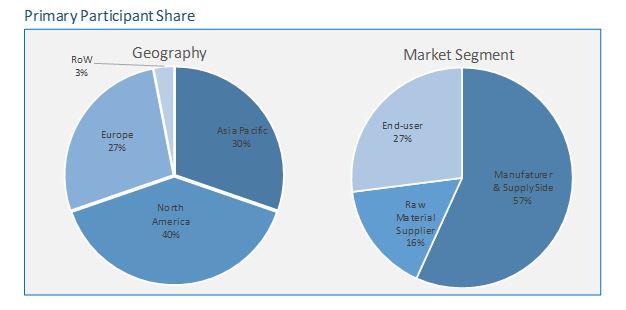
Cosmetic Colorants Market By Type (Dyes, Pigments), By Application (Facial Make-up, Lip products, Eye Make-up, Nail products, Hair Color products) and By Geography – Global Driver, Restraints, Opportunities, Trends, and Forecast to 2023
- July, 2018
- Domain: Chemicals, Materials & Food - Specialty Chemicals,Agro, Pharma, Food & Personal Care
- Get Free 10% Customization in this Report
The cosmetic colorant is a central product of many cosmetic products. In cosmetics, colorants are mainly classified into two varieties, i.e., dyes and pigments. Dyes and pigments are significantly being used in the cosmetic industry as they provide the real color needed in various cosmetic products.
Research Methodology
The cosmetic colorant market has been analyzed by utilizing the optimum combination of secondary sources and in-house methodology along with an irreplaceable blend of primary insights. The real-time assessment of the market is an integral part of our market sizing and forecasting methodology. Our industry experts and panel of primary participants have helped in compiling relevant aspects with realistic parametric estimations for a comprehensive study. The participation share of different categories of primary participants is given below:

Key Market Insights
Cosmetic colorants are widely used for make-up, skin care, hair care, personal hygiene, and fragrance. The pigments are insoluble colorants, which remain in the form of solid particles or crystals while using. Pigments are mainly divided into organic and inorganic pigments. Organic pigments are made of carbons and other molecules such as lakes, toners, and true pigments. Also, organic pigment colors are brighter than inorganic pigments. Inorganic pigments that are popular among consumers include ultramarine, chromium, iron oxides, etc. White pigments such as zinc oxide and titanium dioxide are used in almost all cosmetics. Inorganic pigments are more opaque and resistant to solvents. Generally, pigments are used to achieve a perfect color shade in the products.
Asia Pacific is the largest cosmetic colorant market globally, primarily due to the presence of export-oriented manufacturing capacities and intense domestic demand from various end-user industries. The increase in cosmetic manufacturers is further driving the market growth in the region. The anticipated economic stability in Europe is expected to boost its manufacturing sector, complementing the growth of the cosmetic colorants market. North America is likely to remain the key region with a significant contribution from the US. Few of the prominent companies operating in the cosmetic colorant market are BASF SE, LANXESS, Huntsman Corporation, Merck KGaA, and Clariant.
Types:
- Dyes
- Pigments
End-users:
- Facial Make-up
- Lip Products
- Eye Make-up
- Nail Products
- Hair Color Products
- Others
Geography:
- Asia Pacific
- North America
- Europe
- Rest of the World
1 Report Outline
1.1 Introduction
1.2 Report Scope
1.3 Market Definition
1.4 Research Methodology
1.4.1 Data Collation & In-house Estimation
1.4.2 Market Triangulation
1.4.3 Forecasting
1.5 Study Declaration
1.6 Report Assumptions
1.7 Stakeholders
2 Executive Summary
2.1 The market will experience acceleration from developing countries
2.2 Lip products market is expected to ascend further
3 Market Positioning
3.1 Total Addressable Market (TAM): Cosmetic ingredients Materials
3.1.1 Market Overview
3.1.2 Major Trends
3.2 Segmented Addressable Market
3.3 Related Markets
4 Market Outlook
4.1 Overview
4.2 Value Chain Analysis
4.3 PESTLE
4.4 Porter 5 (Five) Forces
4.5 Patent Analysis
5 Market Characteristics
5.1 Market Segmentation
5.2 Market Dynamics
5.2.1 Drivers
5.2.1.1 Emerging Asian countries
5.2.1.2 Comprehensive solutions for increasing cosmetic product portfolio
5.2.2 Restraints
5.2.2.1 Manufacturing natural functional products
5.2.2.2 Stringent regulations on cosmetic colorants
5.2.3 Opportunities
5.2.3.1 Growing use of enhanced cosmetic pigments
5.2.3.2 Increasing investment on innovative cosmetic color
5.2.4 DRO – Impact Analysis
6 By type: Market Size & Analysis
6.1 Overview
6.2 Pigments
6.3 Dyes
6.4 Vendor Profiles
6.4.1 BASF SE
6.4.2 LANXESS
6.4.3 Huntsman Corporation
6.4.4 Clariant
6.4.5 Merck KGaA
(Overview, business units, geographic revenues, product profile, recent developments, business focus, SWOT analyand business strategy have been covered for all the vendors)
7 End-user: Market Size & Analysis
7.1 Overview
7.2 Facial make-up
7.3 Lip products
7.4 Eye make-up
7.5 Nail products
7.6 Hair color products
7.7 Customers Profile
7.7.1 L’Oreal
7.7.2 New Avon LLC
7.7.3 REVLON
7.7.4 Unilever
7.7.5 Procter and Gamble
(Overview, business units, geographic revenues, product profile, SWOT analysis, and business strategy have been covefor all the customers)
8 Regions: Market Size and Analysis
8.1 Overview
8.2 Asia Pacific
8.3 Europe
8.4 North America
8.5 Rest of the World
(Market segmentation for geography, material type, and end-user have been covered for all the regions)
9 Companies to Watch for
9.1.1 Neelikon
9.1.1.1 Overview
9.2 Expansion of its product line
9.2.1 Sudarshan Chemical Industries Limited
9.2.1.1 Overview
9.3 Increasing investment in R&D
10 Competitive Landscape
10.1 Competitor Comparison Analysis
10.2 Market Landscape
10.2.1 Mergers, Acquisitions & Joint Ventures
10.2.2 Expansion
10.2.3 Exhibition & Product Launch
10.2.4 Restructuring & Repositioning
10.2.5 Awards & Recognition
10.2.6 Others
11 Expert’s Views
Annexure
Acronyms
Research Framework
Infoholic research works on a holistic 360° approach in order to deliver high quality, validated and reliable information in our market reports. The Market estimation and forecasting involves following steps:
- Data Collation (Primary & Secondary)
- In-house Estimation (Based on proprietary data bases and Models)
- Market Triangulation
- Forecasting

Market related information is congregated from both primary and secondary sources.
Primary sources
involved participants from all global stakeholders such as Solution providers, service providers, Industry associations, thought leaders etc. across levels such as CXOs, VPs and managers. Plus, our in-house industry experts having decades of industry experience contribute their consulting and advisory services.
Secondary sources
include public sources such as regulatory frameworks, government IT spending, government demographic indicators, industry association statistics, and company publications along with paid sources such as Factiva, OneSource, Bloomberg among others.
